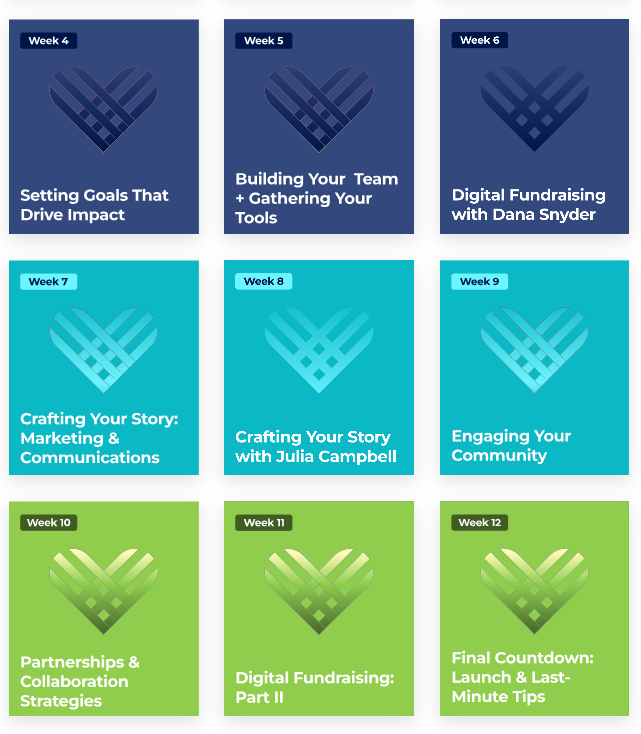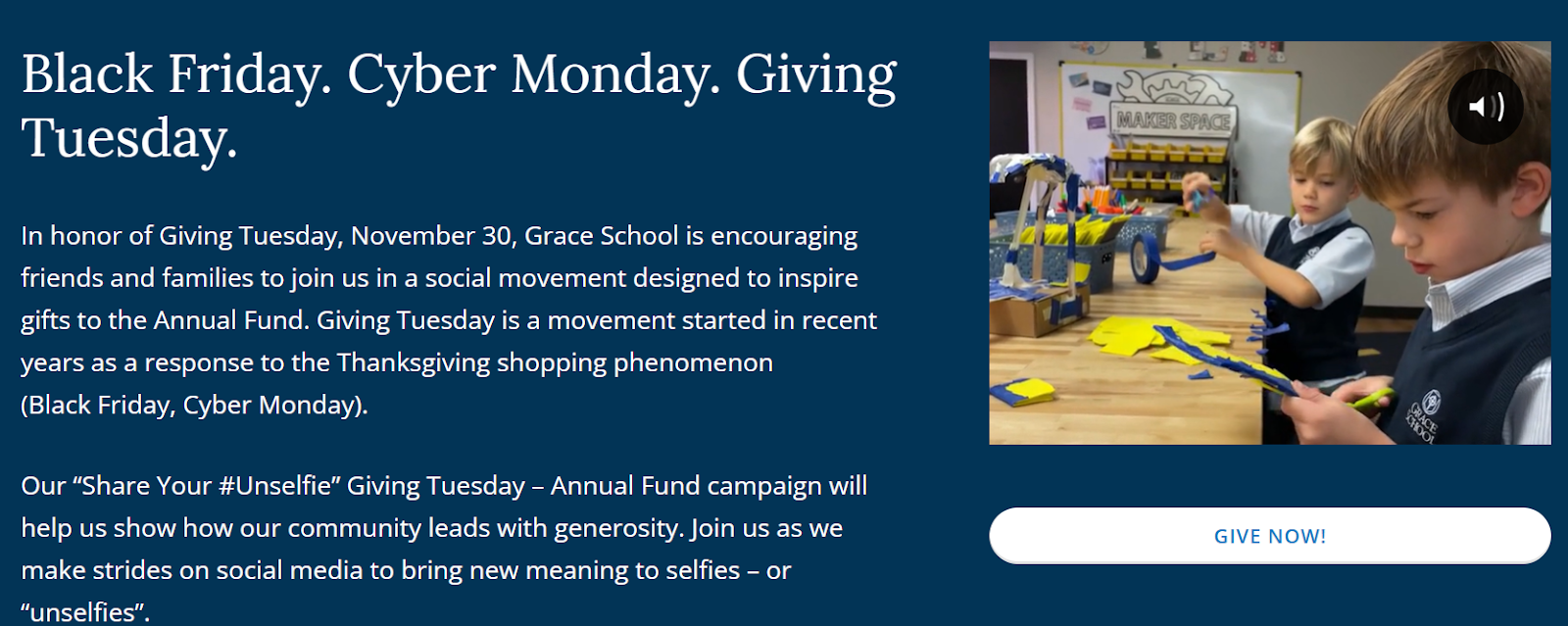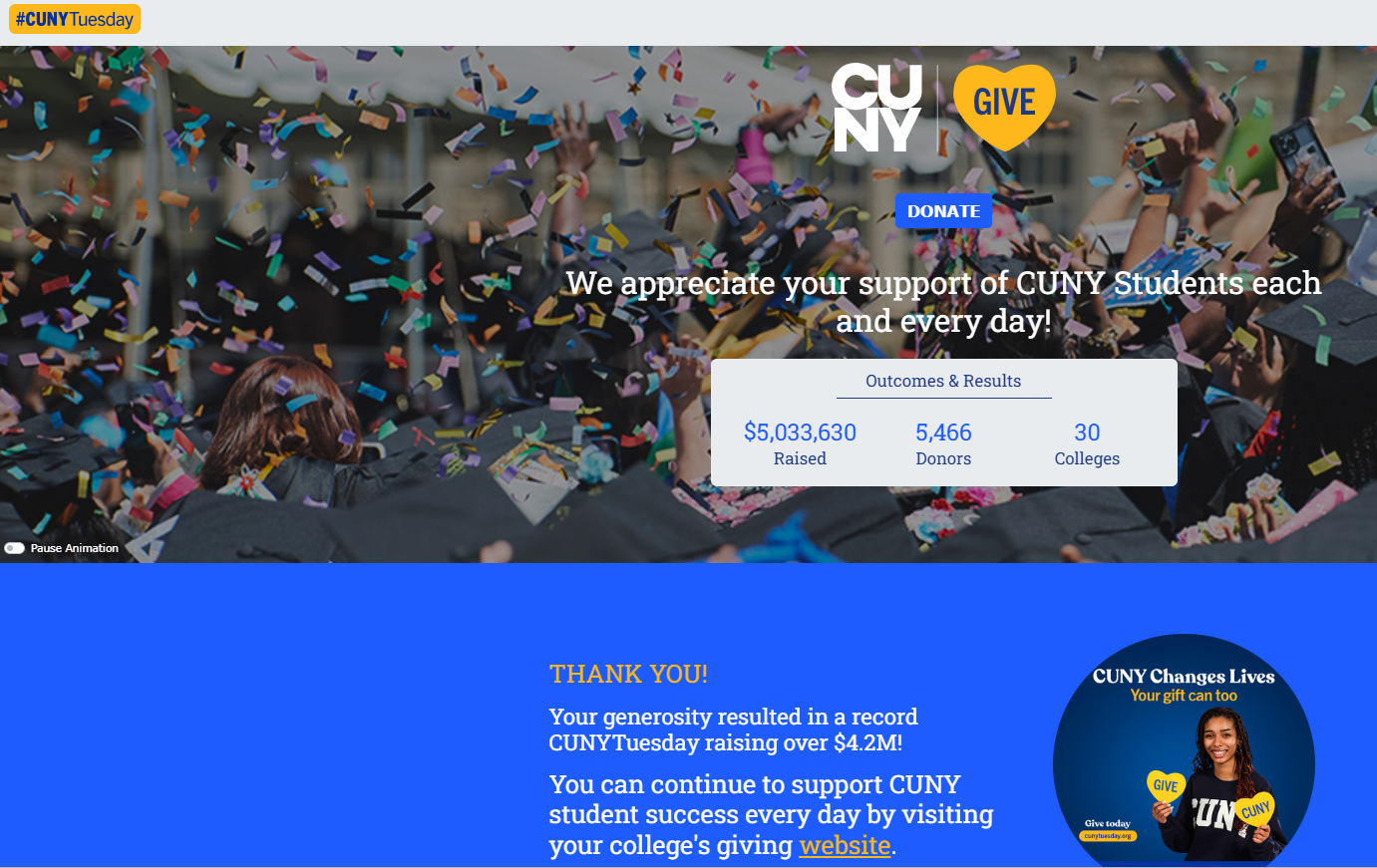How to Improve Your School’s Giving Tuesday Campaign
Every year, GivingTuesday (or Giving Tuesday) gives schools the chance to rally their communities around generosity. With the right Giving Tuesday campaign ideas, you can turn a single day of giving into something that strengthens your institution’s pride, deepens connections, and funds the programs that make a difference. Last year alone, donors contributed $3.6 billion across the United States, marking a 16% jump from the previous year
But a successful Giving Tuesday campaign doesn’t happen by accident. In this blog we will take you through a few proven strategies you can adopt to make sure your Giving Tuesday campaign is at its most effective.
1. Start Planning Early (September–October)
The institutions that meet (and often surpass) their Giving Tuesday goals have one thing in common: they start early.
Giving Tuesday lands right after Thanksgiving, competing for attention with Black Friday sales, holiday shopping, and countless nonprofit appeals. To cut through the noise, your best move is to begin preparing well before November, ideally in September or early October.
The good news? You don’t have to build your plan from scratch. GivingTuesday's official website offers a 12-week countdown planning guide that walks you through exactly what to do each week leading up to the big day. Starting three months out gives you the breathing room to think creatively, build momentum, and avoid the last-minute scramble.

Here’s what early planning gives you:
- Time to craft a compelling purpose: When you plan ahead, you can dig deep into what makes your campaign meaningful instead of rushing to fill space with generic messages.
- A clear roadmap: Early preparation helps you chart every milestone, from when to brief ambassadors, post teasers, send reminders, to finally thanking your donors.
- Defined donor segments: Alumni, parents, and faculty all care about different aspects of your school. Knowing who you’re speaking to lets you tailor your message for each group.
Start now by planning backwards from Giving Tuesday. What should happen a month before? Two weeks before? One week before? Lock in those milestones early and you’ll be thanking yourself later.
2. Define a Purpose That Inspires Giving
A number can be motivating, but a purpose is unforgettable.
A goal might say, “We want to raise $25,000.”, but a purpose says, “We’re raising $25,000 to launch scholarships for three first-generation students this year.” One is a target; the other tells a story of the real impact donors could be making. When your campaign clearly connects donations to outcomes, people give with confidence and heart.
A message that inspired giving could look like:
- “Create emergency grants for students facing unexpected financial hardship.”
- “Expand mental health counseling to serve 50 more students this semester.”
- “Renovate our aging library into a modern learning commons.”
Whatever you choose, make sure your purpose reflects your school’s mission and resonates emotionally with your supporters. When donors can picture the result, they’re far more likely to take action.
3. Craft Relatable Messaging
Your Giving Tuesday message has just a few seconds to capture attention and spark generosity. The best ones are short, emotional, and focused on impact.
A simple framework that works:
- “Every gift, big or small, helps a student [insert specific outcome here] this Giving Tuesday.”
- Avoid vague phrases like “achieve their dreams.” Instead, make it tangible: “get the textbooks they need to succeed” or “attend a field trip that brings lessons to life.”
Take NYU’s example. Their messaging connected the global GivingTuesday movement directly to tangible student impact.
"GivingTuesday is about unleashing the power of generosity worldwide. At NYU, it means investing in the next generation of leaders whose work will create lasting change. Your support today can provide scholarships, mentorship, emergency funds, and countless opportunities for students to flourish at NYU."
Notice how they started with the big picture (global generosity) but quickly zeroed in on specific ways donations make a difference Then, they immediately connected that message to real outcomes: scholarships, mentorships, and emergency funds. That balance between vision and specificity is what makes a message stick.
And don’t forget to mention that small donations matter. Many people assume their $10 or $25 won’t move the needle, but it absolutely does. Try messages like:
- “Just $25 provides school supplies for a student in need.”
- “Your $50 gift covers a week of after-school tutoring.”
Sample Giving Tuesday Messages for Schools:
Create three to five variations of your core message and rotate them across platforms. Include your school’s unique hashtag alongside #GivingTuesday to boost visibility. Need inspiration? Check out Kansas State University’s social media toolkit for adaptable message ideas.

4. Design a Branded Giving Tuesday Graphic
For Giving Tuesday, visuals are your first impression with potential donors. A well-designed graphic makes your campaign instantly recognizable and emotionally engaging.
Rockhurst High School in Kansas City nailed this with their #RockGivingTuesday campaign. Their posts consistently featured:
- their school branding and colors
- the official #GivingTuesday logo
- a clear “Double your impact” call to action
That consistency built trust and recognition at a glance.
You don’t need to start from scratch. GivingTuesday.org offers free branded templates and logo guidelines to help you maintain a professional look while saving time.

What Makes a Great Giving Tuesday Graphic?
- Use school colors: Your audience should recognize your brand instantly while scrolling.
- Include a clear CTA: Add short overlays like “Donate Now,” “Support Students,” or “Double Your Gift.” Make the next step obvious within three seconds.
- Strategic hashtag and logo placement: Keep the official #GivingTuesday logo visible but secondary to your school branding (often in a corner or footer), and pair it with your custom hashtag.
5. Build a Dedicated Giving Tuesday Landing Page
Directing donors to your general donation page might seem simple, but it could actually hurt conversions. On Giving Tuesday, people expect a focused, emotionally engaging experience that feels unique to the day.
A dedicated Giving Tuesday landing page reminds visitors why they’re giving and shows exactly how their gift will be used.
Here’s what to include:
- A mobile-friendly donation form: More than half of donors give through mobile devices, so your form must look and work perfectly on a phone.
- Short, emotional copy and visuals. Use photos or quick videos of students and keep the text crisp.
- Small suggested amounts. Giving Tuesday thrives on volume. Include $10, $25, $50, and $100 options.
- A live progress bar. Real-time updates build excitement and urgency.
- A testimonial or video story. Let a student or parent explain, in their own words, why this campaign matters. Authenticity beats polish every time.
Take inspiration from Grace School’s approach. They embedded a short student video on their landing page and linked it in social posts to drive emotional connection.

6. Promote Strategically on Social Media
Social media can turn your Giving Tuesday campaign from good to unforgettable, but it takes planning your content calendar and rhythm. Create a simple calendar that builds anticipation, peaks on Giving Tuesday, and ends with gratitude.
Here’s an example of what that might look like:
- Two weeks before: Start teasing your campaign: share behind-the-scenes prep, introduce ambassadors, post countdowns.
- One week before: Increase frequency with student stories and preview posts.
- Three days before: Go into campaign mode with multiple daily updates.
- On Giving Tuesday: Post morning, noon, and evening. Share live updates like “We’re 65% there! Help us hit 75% by 3 p.m.!” and student thank-you videos.
- The day after: Celebrate impact, show gratitude! Share totals, photos, and heartfelt thanks.
And some platform-specific tips:
- Facebook: Great for longer updates and older alumni. Consider Facebook’s donation tools.
- Instagram: Focus on visuals and short Reels featuring student voices.
- LinkedIn: Target professional alumni with posts on career readiness and community impact.
Take a page from Save the Elephants. Their Giving Tuesday video of elephants roaming freely, coupled with a triple-match promise, stopped people mid-scroll. For schools, that could be students in action, classrooms buzzing, or alumni sharing quick stories. Even a small paid ad budget ($100–$200) can expand reach to specific alumni groups or parent audiences.

7. Activate Your Ambassadors
Here’s the not-so-secret secret behind the most successful Giving Tuesday campaigns: they’re powered by people. Specifically, it's peer-to-peer fundraising: alumni ambassadors, parent volunteers, student leaders, and faculty champions who create their own mini-campaigns and ask their personal networks to give. When a message comes from someone you know, it hits differently.
Research backs this up: 56% of donors say they’re more likely to give when asked by someone in their circle.
How to make it happen:
- Recruit early. Reach out in September or October to your most active community members.
- Set clear expectations. Tell them exactly what you're asking for: "Share three social media posts between November 20-28" or "Send an email to 10 friends asking them to give."
- Keep them updated. Send regular progress reports. Celebrate when individual ambassadors hit milestones. Create some friendly competition with a leaderboard.
- Thank them publicly. Feature your top fundraisers on social media and in follow-up communications. Recognition matters.
The best part is that ambassador-driven campaigns often bring in new donors who never would have heard about your school otherwise.
The official GivingTuesday Peer-to-Peer Fundraising Toolkit highlights that donors are far more likely to give when a request comes from someone they know and trust, rather than from the institution itself. The toolkit also offers simple ways for ambassadors, such as alumni or parent volunteers, to create personalized fundraising pages, share campaign links across their networks, and rally support for your school’s cause.
8. Use Email to Build Momentum
Email remains one of the most elegant and effective tools for Giving Tuesday: simple, direct, and measurable. But success comes from a sequence, not a single blast.
Try the Four-Email Timeline:
- Announcement Email (Two weeks before) -
Subject: “Mark Your Calendar: Giving Tuesday is December 2”
Introduce your campaign and purpose without asking for donations yet. The goal here is to build anticipation. - Reminder Email (Three days before) -
Subject: “3 Days Until Giving Tuesday! Here’s How Your Gift Makes an Impact”
Share a story, break down donation impact, and remind them to save the date. - Day-Of Appeal (Giving Tuesday morning) -
Subject: “It’s Giving Tuesday. Will You Support Our Students Today?”
This is your big ask. Keep it urgent and clear, include progress updates, and link to your donation page multiple times with prominent CTAs. - Thank You Email (The next day)
Subject: “You Did It! We Reached [X]% of Our Goal!”
Celebrate the success and show impact through photos or short videos. Gratitude drives retention.
Bonus Tip: Segment Your Messages:
Don't send the exact same email to everyone. You can boost your email open rates average by personalizing your approach.
Create different versions for:
- Alumni: Focus on nostalgia and paying it forward to the next generation
- Parents: Emphasize direct impact on current students and school improvements
- Faculty/Staff: Highlight internal pride and collective impact
Minor tweaks to subject lines and opening paragraphs can make a huge difference in engagement.
8. Make Giving Simple and Seamless
Even the most inspiring campaign can lose momentum if donating is a hassle. Think about it from a donor’s point of view: they’re scrolling on their phone during a quick break, they see your post, feel moved to give, click the link… and then get stuck on a clunky, confusing donation form that doesn’t work well on mobile. That’s a lost gift (sometimes multiple ones).
Here’s how to keep the process effortless:
- Optimize for mobile. More than half of nonprofit emails are opened on mobile devices, and donation forms are no different. Test your form on phones and tablets to make sure it’s smooth and intuitive.
- Simplify form fields. Ask only for essentials: name, email, and payment information. Your form shouldn’t require account creation or extra details unless absolutely necessary.
- Offer flexible payment options. Credit cards, Apple Pay, Google Pay, and PayPal give donors convenient choices. In 2024, digital wallet donations more than doubled, proving ease drives results.
- Highlight recurring giving. Include a checkbox like “Make this a monthly gift” with a note such as “Your $25/month supports a student all year long.”
9. Say Thank You and Show Impact
The campaign doesn't end when Giving Tuesday is over. In fact, what you do the next day might be just as important as what you did during the campaign itself. Donor retention is a bit of a challenge right now: that means if you don't immediately thank your Giving Tuesday donors and show them the impact of their gift, there's a chance they won't give again.
The City University of New York (CUNY) used their dedicated thank you page at cunytuesday.org as a central hub to express gratitude and celebrate their record-breaking Giving Tuesday 2024 campaign.

Follow up effectively:
- Send an impact email within 24 hours. Don’t wait. The emotional connection is strongest right after the gift.
Example:
"Thanks to 237 donors like you, we reached 120% of our $20,000 goal! That means we can fully fund our student emergency grant program and help 15 students overcome unexpected financial challenges this semester."
- Share results on social media. Post photos, videos, donor shoutouts, and final totals. Let supporters feel part of something bigger.
- Update your landing page. Swap the donation form for a bold thank-you message and highlight the results. Include visuals of students celebrating or short videos showing how gifts are making a difference.
- Send personalized thank-you notes. Acknowledge ambassadors and top donors by name. Even digital notes work: “Your personal fundraising page brought in $2,500 thank you for your incredible support!”
- Feature impact stories in newsletters. Keep the momentum going by sharing how gifts are being used through December and January.
With these steps you can cultivate long-lasting relationships with your supporters.
10. Repurpose Content Throughout the Year
Your Giving Tuesday campaign is a treasure trove of content you can use year-round.
- Student testimonials can become centerpiece stories in your annual appeal.
- Ambassador videos can feature on your website or alumni magazine.
- Scholarship recipient stories can drive your next email campaign.
Use Giving Tuesday as a springboard for recurring donations. A follow-up email in January might say: “Your Giving Tuesday gift made a real difference. Would you consider making it monthly?”
Highlight your most engaged ambassadors in annual reports or invite them to participate in alumni boards. Celebrate your super-fans! They’re critical for future campaigns.
Social proof also matters: “Last year, 500 donors came together on Giving Tuesday to raise $35,000” is a powerful motivator for new donors and ambassadors.
Back in 2021, the School of the Holy Child in Rye, New York, used a smart strategy that still works beautifully today. Their GivingTuesday campaign celebrated the success of the previous year, proudly sharing that in 2020, their community raised $375,000 from 525 donors — and invited supporters to help surpass that goal. The result? They raised $402,855 in 2021, proving how past impact can motivate even greater generosity year after year.
Giving Tuesday doesn't have to be a one-off event. When you treat it as part of your larger annual fundraising strategy, you maximize its impact well beyond a single day.
Final Thoughts
Giving Tuesday is only growing. With projections estimating $4 billion raised in 2025, schools that show up prepared will see significant returns.
But true success is at the confluence of an effective hashtag, a simple but elegant landing page, and driving connection with your donors. It comes from showing donors exactly how their gift makes a difference. It comes from making it easy to give and impossible to ignore.
Start early. Tell compelling stories. Activate your community. Make giving frictionless. Show gratitude.
When you follow this approach, Giving Tuesday can be your most successful campaign yet. Almabase helps schools bring it all together: personalized campaigns, streamlined donation processing, and purpose-built tools that maximize giving. Request a demo today and transform how your school connects with donors.
About the author

Kiran is an educator and pedagogy enthusiast, passionate about the transformative impact of education, kindness, and creativity on individuals and communities.
As an artist, she brings a unique perspective to her work and is committed to inspiring growth, empathy, and understanding
Blackbaud, the leading provider of software for powering social impact, and Almabase, the digital-first alumni engagement solution, have announced the expansion of their partnership to the education sectors of Canada and the United Kingdom. The partnership will provide institutions with a modern, digital-first solution to improve constituent data, drive self-serve engagement, and boost event participation.
A Unified Vision
The partnership aligns with Blackbaud’s commitment to customer-centric innovation across digital engagement, Advancement CRM, and financials.
“Partners bring integrated capabilities that extend capabilities and outcomes for Blackbaud customers. We are thrilled that Almabase’s offering, integrated with Blackbaud Raiser’s Edge NXT® and leveraging Blackbaud’s best-in-class payment solution, Blackbaud Merchant Services™, is now available to even more of our customers around the world.”
- Liz Price, Sr. Director of Global Partners at Blackbaud

.svg)